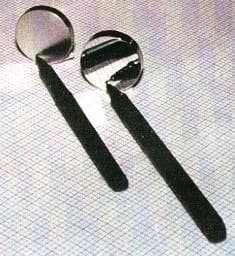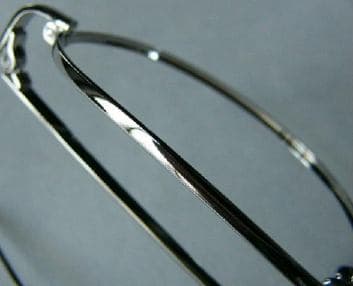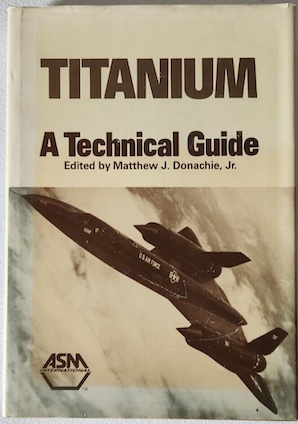
-----
Titanium porosity, watch finishes, sealing, etc.
Q. Dear group,
Over the past few years, a lot of titanium watches have been introduced on the market, ranging from Swiss to Japanese manufacturers. Although many of its merits have been hailed as being superior to stainless steel cases and bracelets, I have noticed some disturbing oddities about the titanium watch cases. In the early years of its introduction, (I'm guessing mid to late 1980's to early 1990's) it seemed as if the titanium used was softer than what is currently on the market, I am also guessing it was used in its purer form. Bracelet links used to bend faster and sometimes showed signs of fissure at stress points. I understand there has been an improvement by certain mfgrs in the coating and hardening of the titanium watch surface, the details of which I am not aware of in detail as I am not into production, but rather in their repair and restoration.
My questions are twofold. 1. Why are almost all titanium watches offered in a frosty (or matte) finish? 2. What is the surface porosity of titanium watches? Especially when compared to stainless steel. Depending on the outcome of the second question, I shall be in a better position to ask a third question. Thank you kindly for your time and assistance. I hope to return the favor.
Best regards,
Manuel Jean- Montreal, Quebec, Canada
2003
A. Good question. I have a partial answer. First of all, I am not familiar with the question in relationship to titanium watches. I have tried to surface finish titanium for a couple of applications and all of which were not too successful. The porosity of this metal is great, well over 35 RMS, or at least to samples I got from other sources to process. The quickest way to get a smooth finish was via an abrasive wheel system. Because of this processing time and/or labor, it seems that most processing is done with abrasive blast methods.

AF Kenton
retired business owner - Hatboro, Pennsylvania
adv.
Timing and/or labor of titanium polishing can be replaced by quick titanium electropolishing. However, surface must be mechanically prepared to the roughness of 1-2 micron. For most of the alloys (grade 1-4 and single-phase alloy) the surface will be perfect mirror reflection. Two-phase alloy produces bright surface also, however under the sunlight you will see the grain structure. Our method uses electrolyte based on salts dissolved in water.


Anna Berkovich
Russamer Lab - Pittsburgh, Pennsylvania
(ed. update July, 2025: sorry, Anna has retired)
Coating porous Titanium sintered discs with Platinum - Techniques and Suppliers
Q. I need to put 20-40 nanometers of Platinum on porous Titanium discs.
We are trying to prevent or at least defer corrosion in a pure oxygen and deionised water environment.
I read that a primer coating of Vanadium/Tantalum or other will help the Platinum bond to the substrate but I have no details.
I need some thoughts on the best techniques and possible process steps.
RFQ: Please let me know if know somebody can help.
Designer - Kingston, Ontario, Canada
2007
Ed. note: This RFQ is outdated, but technical replies are welcome, and readers are encouraged to post their own RFQs. But no public commercial suggestions please ( huh? why?).
How to Achieve Large Pores at Titanium Surface
Q. Dear All, I am a PhD student working on titanium implants. I was able to produce porous titanium surface by using 1wt% HF+1M H3PO4.The pore sizes were 300-500 nm. I need pores larger than 2 microns. Could any one please give me any suggestions? Thanks
Toulou Shokuhfstudent - Michigan, USA
September 8, 2008
A. Try a mixture of 5% KOH + 5% H2O2. It will work slowly, perhaps 4-8 hours @ ambient temp.

Jeffrey Holmes, CEF
Spartanburg, South Carolina
A. Dear Toulou Shokuhf,
You have to suitably modify the pH, current density and treatment time to modify the pore size.

T.S.N. Sankara Narayanan
- Chennai, Tamilnadu, India
(ed.note: The good doctor offers a fascinating blog, "Advancement in Science" )
Titanium clear sealing
February 23, 2010Good evening everyone.
I have a finishing problem on a Titanium plate which after being machined-polished tends to oxidate and become brownish. I am looking for some clear permanent lacquer to treat it.
The plate is cut and very light sanded, the end finishing is very smooth and platinum-like but after a few days the oxidation makes the pure titanium color brownish a little.
In addiction it takes easily fingerprints and to clean them up you make a disaster with any tested cleaning solution (a little better with pure water and robust rubbing).
The combination of fingerprints polishing and brownish oxidation creates brown shades on the platter surface which are very difficult to remove.
The solution I thought is to lacquer the plate with some clear permanent lacquer, non yellowing, UV and friction resistant (or it will soon spoil).
The finishing I need is Jewelry Titanium (like Ti watch or ring).
If someone can help I'll be grateful. Cheers.
product designer - Turin, Italy
A. We think that the cause of pigmentation is thin film of amorphous and/or deformed titanium on the surface. Such film is always formed after mechanical polishing of titanium alloy. Such thin layer of deformed metal is very easily oxidized, forming porous layer of titanium oxide, where you see yellowish spots or fingerprints. This thin porous layer can be removed electrochemically or chemically. See attached photo of electropolished titanium surface.

adv.
Contact us if you need help.

Anna Berkovich
Russamer Lab - Pittsburgh, Pennsylvania
(ed. update July, 2025: sorry, Anna has retired)
March 2, 2010
A. There are some new nanotechnologies that you can try, like anti-fingerprints or easy to clean products, all of them very easy to apply and to check if it works
Ricardo BursteinBnei Berak, Israel
March 13, 2010
Q. I have been informed by a famous manufacturer of Swiss watches that the stainless steel casing of my watch has become porous over the past 25 years and must now be replaced. Is this possible?
Best regards
- United Kingdom
April 12, 2011
A. Hi Brian.
"Porous" to the extent that it is difficult to keep it bright and shiny sounds believable. Porous to the extent that it's no longer waterproof or hermetically sealed sounds ludicrous.
Regards,

Ted Mooney, P.E.
Striving to live Aloha
finishing.com - Pine Beach, New Jersey
Ted can be retained for immediate
answers or long term project help
Q, A, or Comment on THIS thread -or- Start a NEW Thread
